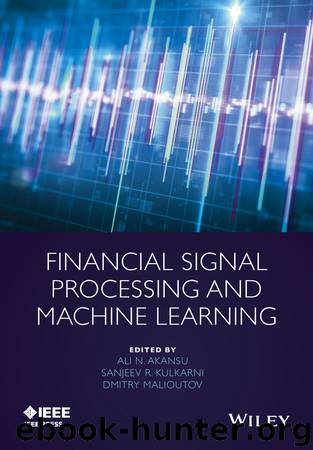Financial Signal Processing and Machine Learning by Akansu Ali N.; Kulkarni Sanjeev R.; Malioutov Dmitry M. & Sanjeev R. Kulkarni & Dmitry Malioutov

Author:Akansu, Ali N.; Kulkarni, Sanjeev R.; Malioutov, Dmitry M. & Sanjeev R. Kulkarni & Dmitry Malioutov
Language: eng
Format: epub
Publisher: Wiley
Published: 2015-09-28T00:00:00+00:00
6.4.2.3 Empirical Study
We study monthly returns on all the S&P 500 constituents from the CRSP database for the period January 1980 to December 2012, during which a total of 1170 stocks have entered the index for our study. Testing of market efficiency is performed on a rolling window basis: for each month from December 1984 to December 2012. The test statistics are evaluated using the preceding 60 months' returns . The panel at each testing month consists of stocks without missing observations in the past 5 years, which yields a cross-sectional dimension much larger than the time-series dimension . For testing months , we fit the Fama–French three-factor (FF-3) model:
6.36
for and , where represents the return for stock at month ; is the risk-free rate; and , and constitute the FF-3 model's market, size, and value factors.
Table 6.3 summarizes descriptive statistics for different components and estimates in the model. On average, 618 stocks (which is more than 500 because we are recording stocks that have ever become the constituents of the index) enter the panel of the regression during each 5-year estimation window, of which 5.5 stocks are selected by . The threshold is about 0.45 on average, which changes as the panel size changes for every window of estimation. The selected stocks have much larger alphas than other stocks do, as expected. As far as the signs of those alpha estimates are concerned, of all the estimated alphas are positive, and of all the selected alphas are positive. This indicates that market inefficiency is primarily contributed by stocks with extra returns, instead of a large portion of stocks with small alphas, demonstrating the sparse alternatives. In addition, we notice that the -values of the thresholded Wald test is generally smaller than that of the test given by Pesaran and Yamagata (2012).
Table 6.3 Variable descriptive statistics for the Fama–French three-factor model (Adapted from Fan et al., 2014b)
Download
This site does not store any files on its server. We only index and link to content provided by other sites. Please contact the content providers to delete copyright contents if any and email us, we'll remove relevant links or contents immediately.
| Antennas | Microwaves |
| Mobile & Wireless | Networks |
| Radar | Radio |
| Remote Sensing & GIS | Satellite |
| Signal Processing | Telephone Systems |
| Television & Video |
Whiskies Galore by Ian Buxton(41883)
Introduction to Aircraft Design (Cambridge Aerospace Series) by John P. Fielding(33064)
Small Unmanned Fixed-wing Aircraft Design by Andrew J. Keane Andras Sobester James P. Scanlan & András Sóbester & James P. Scanlan(32744)
Craft Beer for the Homebrewer by Michael Agnew(18145)
Turbulence by E. J. Noyes(7940)
The Complete Stick Figure Physics Tutorials by Allen Sarah(7310)
Kaplan MCAT General Chemistry Review by Kaplan(6867)
The Thirst by Nesbo Jo(6830)
Bad Blood by John Carreyrou(6555)
Modelling of Convective Heat and Mass Transfer in Rotating Flows by Igor V. Shevchuk(6391)
Learning SQL by Alan Beaulieu(6212)
Weapons of Math Destruction by Cathy O'Neil(6148)
Man-made Catastrophes and Risk Information Concealment by Dmitry Chernov & Didier Sornette(5924)
Digital Minimalism by Cal Newport;(5667)
Life 3.0: Being Human in the Age of Artificial Intelligence by Tegmark Max(5476)
iGen by Jean M. Twenge(5367)
Secrets of Antigravity Propulsion: Tesla, UFOs, and Classified Aerospace Technology by Ph.D. Paul A. Laviolette(5310)
Design of Trajectory Optimization Approach for Space Maneuver Vehicle Skip Entry Problems by Runqi Chai & Al Savvaris & Antonios Tsourdos & Senchun Chai(5011)
Pale Blue Dot by Carl Sagan(4913)
